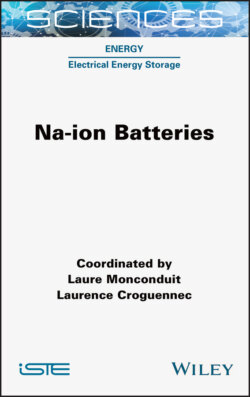Читать книгу Na-ion Batteries - Laure Monconduit - Страница 11
I.1. Why Na-ion batteries?
ОглавлениеClimate changes and constraints of fossil resources result in the exploration of green and sustainable resources from renewable energy resources (solar, wind, hydro, tidal and geothermal energies), and their storage has become a critical issue in recent years. The development of large-scale energy storage systems has push the research on Li-ion batteries (LIBs), recognized as the electrochemical energy storage system showing the higher energy density since their first commercialization in 1991. Today, LIBs still dominate the market as the high-energy and power source for portable electronic devices. The limited abundance (Figure I.1) and especially the uneven distribution of lithium, added to the emerging huge demand for electrical energy storage, could increase the cost and sustainability of lithium. Almost 25% of Li reserves are expected to be depleted by electric vehicle (EV) applications by 2050 (Vikström et al. 2013). Moreover, the lithium supply is concentrated in a few areas, mainly in South America and Australia. Only a few companies dominate the lithium market such as Albemarle (ALB US), Rockwood Lithium, SQM (SQM US), FMC (FMC US) and Chengdu Tianqi (China). As a result, the price of Li2CO3 is continuously growing and is foreseen to dramatically rise with that of the EV
market. Li recycling could support the supply of Li with a recycling rate of 50–100% in 2050. Since 2006, Umicore is providing recycling services for lithium-ion (Li-ion) and nickel metal hydride batteries (NiMH) from all possible applications. They are now able to recycle lithium from LIB waste through both pyrometallurgical as hydrometallurgical flowsheets. Among other actions, Eramet, Suez and BASF have formed an alliance, which is supported by Europe for an innovative research program to recycle the LIBs of used electric vehicles, and recycle the active materials such as lithium, nickel and cobalt in a form that is sufficiently pure to be reusable in a new battery (https://www.basf.com/fr/fr/media/Communiques-de-presse-France).
This situation increased the necessity to explore alternative battery chemistries. Na is the sixth most abundant element in the Earth’s crust (≈2.6%), and unlimited Na resources are available from sea water (Figure I.1).
Figure I.1. Abundance of elements in the Earth’s crust (Pan et al. 2013). For a color version of this figure, see www.iste.co.uk/monconduit/batteries.zip
Sodium is the second lightest and smallest alkali metal next to lithium (1.02 Å for Na+ vs. 0.76 Å for Li+), however its larger ionic radius can result in sluggish reaction kinetics in electrode materials commonly used in LIBs such as layered oxides and graphite, usually producing lower capacity, lower rate capability and poor cycling stability. Moreover, the higher standard redox potential of Na (−2.71 V vs. SHE) than Li (−3.04 V vs. SHE) and its larger atomic weight represent other disadvantages when considering Na-ion batteries (NIBs), since they will trigger a lower energy density.
Na layered oxides intercalation compounds were first studied in the 1980s (Delmas et al. 1981) and have reemerged since 2012 at the positive electrode of NIBs for large-scale electrochemical storage systems at room temperature (Kim et al. 2012). Huge efforts were made to use graphite in NIBs at the beginning of the 1920s (Stevens and Dahn 2001), without success, leading then to the development of hard carbons at the negative electrode of NIBs. NIBs have received remarkable attention and are now recognized as the most promising alternative to LIBs, especially for large-scale energy storage applications. Much effort has been devoted to developing novel electrode materials and electrolytes for NIBs with high performance.
In this book, we summarize the most recent progress and the main challenges in the field: (1) for the positive and negative electrode materials, from the layered oxides to the polyanionic frameworks and from the carbons to the alloys, but also considering the development of new binders, additives and electrode formulation; (2) for the electrolytes, with a state of the art of currently used liquid and solid electrolytes in NIBs, and a special focus on those based on ionic liquids (IL); and
(3) in the knowledge of solid electrolyte interphase (SEI) layer formation and evolution upon cycling of NIBs. Specific attention has been paid to understanding the sodiation/desodiation processes and ageing phenomena. Maturity and understanding of the LIB technology are obviously helping and accelerating the comprehension and the rapid development of NIBs. Last but not least, two chapters are devoted to demonstrating that NIB technology is not only a viable alternative to LIBs, but it is also competitive in terms of cost, performance and safety and is already developed to be introduced rapidly into the market.
